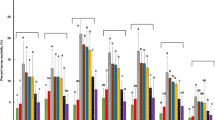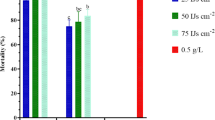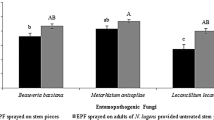Abstract
Musca domestica L. is a cosmopolitan nuisance of high sanitary importance. Entomopathogenic fungi are innovative and attractive tools for integrated control of the housefly to overcome insufficient levels of control caused by increasing resistance of this pest against chemical insecticides. High virulence of a fungal strain is a prerequisite to develop a mycoinsecticide, and the present study investigated the potential of hypocrealean fungi from the genera Beauveria, Clonostachys, Cordyceps, Akanthomyces, Metarhizium, and Tolypocladium, isolated from mosquitoes in Central Brazil against M. domestica. The highest mortalities (larvae, pupae, and adults) were caused by Metarhizium humberi IP 478 (98%) and IP 421 (90%), Metarhizium anisopliae IP 432 (85%), Beauveria bassiana IP 433 (82%), and Tolypocladium cylindrosporum IP 425 (68%) after a 23-day exposure of initially pre-pupating third instar larvae to conidia mixed with vermiculite. Lethal concentrations to kill 90% of adults of IP 433 and IP 478 were 5 × 107 and 108 conidia g−1 substrate, respectively. Fifty percent of adults were killed within 4 to 5 days of exposure initially as pupae close to emergence to substrate treated with conidia of IP 478 or IP 433 at 1.1 × 108 conidia g−1, respectively. The other fungal strains tested were less virulent. The results demonstrate high potentials for conidial preparations in vermiculite of IP 433 and IP 478 as candidates for the biological control of both pre-pupating larvae, pupae, and emerging adults of houseflies.


Similar content being viewed by others
References
Acharya N, Rajote EG, Jenkins NE, Thomas MB (2015) Potential for biocontrol of house flies, Musca domestica, using fungal biopesticides. Biocontrol Sci Techn 25:513–524. https://doi.org/10.1080/09583157.2014.992862
Anderson RD, Bell AS, Branford S, Paaijmans KP, Thomas MB (2011) Comparative growth kinetics and virulence of four different isolates of entomopathogenic fungi in the house fly (Musca domestica L.). J Invertebr Pathol 107:179–186. https://doi.org/10.1016/j.jip.2011.04.004
Barson G, Renn N, Bywater AF (1994) Laboratory evaluation of six species of entomopathogenic fungi for the control of the house fly (Musca domestica L.), a pest of intensive animal units. J Invertebr Pathol 64:107–113. https://doi.org/10.1006/jipa.1994.1078
Bidochka MJ, Kamp AM, Lavender TM, Dekoning J, De Croos JN (2001) Habitat association in two genetic groups of the insect-pathogenic fungus Metarhizium anisopliae: uncovering cryptic species? Appl Environ Microb 67:1335–1342. https://doi.org/10.1128/AEM.67.3.1335-1342.2001
Carswell I, Spooner-Hart R, Milner RJ (1998) Laboratory susceptibility of Musca domestica L. (Diptera: Muscidae) and Bactrocera tryoni (Frogatt) (Diptera: Tephritidae) to an isolate of Metarhizium anisopliae (Metsch.) Sorokin. Aust J Entomol 37:281–284. https://doi.org/10.1111/j.1440-6055.1998.tb01584.x
Chauhan N, Malik A, Sharma S (2018) Repellency potential of essential oils against housefly, Musca domestica L. Environ Sci Pollut R 25:4707–4714. https://doi.org/10.1007/s11356-017-0363-x
Duarte GF, Rodrigues J, Fernandes ÉKK, Humber RA, Luz C (2015) New insights into the amphibious life of Biomphalaria glabrata and susceptibility of its egg masses to fungal infection. J Invertebr Pathol 125:31–36. https://doi.org/10.1016/j.jip.2014.12.013
Ekesi S (1999) Selection of virulent isolates of entomopathogenic hyphomycetes against Clavigralla tomentosicollis Stål and evaluation in cage experiment using three cowpea varieties. Mycopathologia 148:131–139. https://doi.org/10.1023/A:1007122622650
Elya C, De Fine Licht H (2021) The genus Entomophthora: bringing the insect destroyers into the twenty-first century. IMA Fungus 12:34. https://doi.org/10.1186/s43008-021-00084-w
Farooq M, Freed S (2016) Infectivity of housefly, Musca domestica (Diptera: Muscidae) to different entomopathogenic fungi. Braz J Microbiol 47:807–816. https://doi.org/10.1016/j.bjm.2016.06.002
Fernandes ÉKK, Keyser CA, Chong JP, Rangel DEN, Miller MP, Roberts DW (2010) Characterization of Metarhizium species and varieties based on molecular analysis, heat tolerance and cold activity. J Appl Microbiol 108:115–128. https://doi.org/10.1111/j.1365-2672.2009.04422.x
Fernandes EG, Valério HM, Borges MAZ, Mascarin GM, Silva CE, Sand ST (2013) Selection of fungi for the control of Musca domestica in aviaries. Biocontrol Sci Techn 23:1256–1266. https://doi.org/10.1080/09583157.2013.826343
Filgueiras MDG (2017) Atividade inseticida de fungos entomopatogênicos e do alcaloide matrine em larvas de Musca domestica Linnaeus, 1758 (Diptera: Muscidae). Dissertation, Federal University of Goiás
Hubner-Campos RF, Leles RN, Rodrigues J, Luz C (2013) Efficacy of entomopathogenic hypocrealean fungi against Periplaneta americana. Parasitol Int 62:517–521. https://doi.org/10.1016/j.parint.2013.07.013
Humber RA (2012) Identification of entomopathogenic fungi. In: Lacey LA (ed) Manual of techniques in invertebrate pathology. Academic Press, Amsterdam, pp 153–189
Imoulan A, Hussain M, Kirk PM, Meziane AE, Yao Y-J (2017) Entomopathogenic fungus Beauveria: host specificity, ecology and significance of morpho-molecular characterization in accurate taxonomic classification. J Asia-Pac Entomol 20:1204–1212. https://doi.org/10.1016/j.aspen.2017.08.015
Islam W, Adnan M, Shabbir A, Naveed H, Abubakar YS, Qasim M, Tayyab M, Noman A, Shahid Nisar M, Khan KA, Ali H (2021) Insect-fungal-interactions: a detailed review on entomopathogenic fungi pathogenicity to combat insect pests. Microb Pathogenesis 159:105122. https://doi.org/10.1016/j.micpath.2021.105122
Kalsbeek V, Mullens BA, Jespersen JB (2001) Field studies of Entomophthora (Zygomycetes: Entomophthorales)-induced behavioral fever in Musca domestica (Diptera: Muscidae) in Denmark. Biol Control 21:264–273. https://doi.org/10.1006/bcon.2001.0943
Khamesipour F, Lankarani KB, Honarvar B, Kwenti TE (2018) A systematic review of human pathogens carried by the housefly (Musca domestica L.). BMC Public Health 18:1049. https://doi.org/10.1186/s12889-018-5934-3
Kottek M, Grieser J, Beck C, Rudolf B, Rubel F (2006) World map of the Köppen-Geiger climate classification updated. Meteorol Z 15:259–263. https://doi.org/10.1127/0941-2948/2006/0130
Kramer JP, Steinkraus DC (1981) Culture of Entomophthora muscae in vivo and its infectivity for six species of muscoid flies. Mycopathologia 76:139–143. https://doi.org/10.1007/BF00437194
Lecuona RE, Turica M, Tarocco F, Crespo DC (2005) Microbial control of Musca domestica (Diptera: Muscidae) with selected strains of Beauveria bassiana. J Med Entomol 42:332–336. https://doi.org/10.1093/jmedent/42.3.332
Levine OS, Levine MM (1991) Houseflies (Musca domestica) as mechanical vectors of shigellosis. Rev Infect Dis 13:688–696. https://www.jstor.org/stable/4456042
López Lastra CC, Siri A, García JJ, Eilenberg J, Humber RA (2006) Entomophthora ferdinandii (Zygomycetes: Entomophthorales) causing natural infections of Musca domestica (Diptera: Muscidae) in Argentina. Mycopathologia 161:251–254. https://doi.org/10.1007/s11046-005-0248-2
Luz C, Rodrigues J, Rocha LFN (2012) Diatomaceous earth and oil enhance effectiveness of Metarhizium anisopliae against Triatoma infestans. Acta Trop 122:29–35. https://doi.org/10.1016/j.actatropica.2011.11.014
Luz C, D’Alessandro W, Rodrigues J, Fernandes ÉKK (2016) Efficacy of water- and oil-in-water-formulated Metarhizium anisopliae in Rhipicephalus sanguineus eggs and eclosing larvae. Parasitol Res 115:143–149. https://doi.org/10.1007/s00436-015-4729-z
Luz C, Rocha LFN, Montalva C, Souza DA, Botelho ABRZ, Lopes RB, Faria M, Delalibera IJ (2019) Metarhizium humberi sp. nov. (Hypocreales: Clavicipitaceae), a new member of the PARB clade in the Metarhizium anisopliae complex from Latin America. J Invertebr Pathol 166:107216. https://doi.org/10.1016/j.jip.2019.107216
Machtinger ET, Weeks ENI, Geden CJ, Kaufman PE (2016) House fly (Musca domestica) (Diptera: Muscidae) mortality after exposure to fungal commercial formulations in a sugar bait. Biocontrol Sci Techn 26:1444–1450. https://doi.org/10.1080/09583157.2016.1210085
Malik A, Singh N, Satya S (2007) House fly (Musca domestica): a review of control strategies for a challenging pest. J Environ Sci Heal B 42:453–469. https://doi.org/10.1080/03601230701316481
Mishra S, Kumar P, Malik A, Satya S (2011) Adulticidal and larvicidal activity of Beauveria bassiana and Metarhizium anisopliae against housefly, Musca domestica (Diptera: Muscidae), in laboratory and simulated field bioassays. Parasitol Res 108:1483–1492. https://doi.org/10.1007/s00436-010-2203-5
Mishra S, Kumar P, Malik A (2013) Preparation, characterization, and insecticidal activity evaluation of three different formulations of Beauveria bassiana against Musca domestica. Parasitol Res 112:3485–3495. https://doi.org/10.1007/s00436-013-3529-6
Mishra S, Kumar P, Malik A (2017) Evaluation of Beauveria bassiana infection in the hemolymph serum proteins of the housefly, Musca domestica L. (Diptera: Muscidae). Environ Sci Pollut R 24:24714–24724. https://doi.org/10.1007/s11356-017-0193-x
Montalva C, dos Santos K, Collier K, Fernandes ÉKK, Luz C, Humber RA (2016) First report of Leptolegnia chapmanii (Peronosporomycetes: Saprolegniales) affecting mosquitoes in central Brazil. J Invertebr Pathol 136:109–116. https://doi.org/10.1016/j.jip.2016.03.012
Montalva C, Silva JJ, Rocha LFN, Luz C, Humber RA (2018) Characterization of Tolypocladium cylindrosporum (Hypocreales, Ophiocordycipitaceae) isolates from Brazil and their efficacy against Aedes aegypti (Diptera, Culicidae). J Appl Microbiol 126:266–276. https://doi.org/10.1111/jam.14093
Mwamburi LA, Laing MD, Miller RM (2019) External development of the entomopathogenic fungus Beauveria bassiana on the housefly (Musca domestica). P Natl Acad Sci India B 89:833–839. https://doi.org/10.1007/s40011-018-0994-9
Nazni WA, Luke H, Wan-Rozita WN, Abdullah AG, Sa’diyah I, Azahari AH, Zamree I, Tan SB, Lee HL, Sofian MA (2005) Determination of the flight range and dispersal of the house fly, Musca domestica (L.) using mark release recapture technique. Trop Biomed 22:53–61
Renn N, Bywater AF, Barson G (1999) A bait formulated with Metarhizium anisopliae for the control of Musca domestica L. (Dipt., Muscidae) assessed in large-scale laboratory enclosures. J Appl Entomol 123:309–314. https://doi.org/10.1046/j.1439-0418.1999.00374.x
Rocha LFN, Sousa NA, Rodrigues J, Catão AML, Marques CS, Fernandes ÉKK, Luz C (2015) Efficacy of Tolypocladium cylindrosporum against Aedes aegypti eggs, larvae and adults. J Appl Microbiol 119:1412–1419. https://doi.org/10.1111/jam.12945
Rodrigues J, Borges PR, Fernandes ÉKK, Luz C (2019) Activity of additives and their effect in formulations of Metarhizium anisopliae s.l. IP 46 against Aedes aegypti adults and on post mortem conidiogenesis. Acta Trop 193:192–198. https://doi.org/10.1016/j.actatropica.2019.03.002
Rodrigues J, Bergamini C, Montalva C, Humber RA, Luz C (2021) Simple method to detect and to isolate entomopathogenic fungi (Hypocreales) from mosquito larvae. J Invertebr Pathol 182:107581. https://doi.org/10.1016/j.jip.2021.107581
Santoro PH, Neves PM, Alexandre TM, Sartori D, Alves LFA, Fungaro MHP (2008) Selection of Beauveria bassiana isolates to control Alphitobius diaperinus. J Invertebr Pathol 97:83–90. https://doi.org/10.1016/j.jip.2007.07.009
Scott JG (2017) Evolution of resistance to pyrethroid insecticides in Musca domestica. Pest Manag Sci 73:716–722. https://doi.org/10.1002/ps.4328
Shah RM, Shad SA, Abbas N (2015) Mechanism, stability and fitness cost of resistance to pyriproxyfen in the house fly, Musca domestica L. (Diptera: Muscidae). Pest Biochem Phys 119:67–73. https://doi.org/10.1016/j.pestbp.2015.02.003
Steinkraus DC, Geden CJ, Rutz DA, Kramer JP (1990) First report of the natural occurrence of Beauveria bassiana in Musca domestica. J Med Entomol 27:309–312. https://doi.org/10.1093/jmedent/27.3.309
Stone LBL, Bidochka MJ (2020) The multifunctional lifestyles of Metarhizium: evolution and applications. Appl Microbiol Biotechnol 104:9935–9945. https://doi.org/10.1007/s00253-020-10968-3
Torres MJ, Rocha VF, Audisio MC (2016) Laboratory evaluation of Lactobacillus johnsonii CRL1647 metabolites for biological control of Musca domestica. Entomol Exp Appl 159:347–353. https://doi.org/10.1111/eea.12445
Wang S, Leclerque A, Pava-Ripoll M, Fang W, St Leger RJ (2009) Comparative genomics using microarrays reveals divergence and loss of virulence-associated genes in host-specific strains of the insect pathogen Metarhizium anisopliae. Eukaryot Cell 8:888–898. https://doi.org/10.1128/EC.00058-09
Weeks ENI, Machtinger ET, Gezan SA, Kaufmann PE, Geden CJ (2017) Effects of four commercial fungal formulations on mortality and sporulation in house flies (Musca domestica) and stable flies (Stomoxys calcitrans). Med Vet Entomol 31:15–22. https://doi.org/10.1111/mve.12201
Acknowledgements
We are grateful to Lic. Graciela Minardi from the CEPAVE for her contribution in statistical analysis.
Funding
This study was supported by CAPES (Coordination of the Improvement of Higher Education; Brasília, Brazil) Science without Borders funds (PVE 71/2013, 149988) and scholarships to M.E.R.P., K.S., M.D.G.F., C.M., and R.A.H. We also thank the National Council for Scientific and Technological Development (CNPq) of Brazil for grants to É.K.K.F. (PQ 308850/2015–7) and C.L. (PQ 308189/2013–2).
Author information
Authors and Affiliations
Contributions
CL, RAH and ÉKKF conceived the research. MERP, ÉKKF and CL designed the experiments. MERP, KRS, MDGF and CM performed the experiments. CL, MERP and RAH wrote the paper. All authors read and approved the manuscript.
Corresponding author
Ethics declarations
Conflict of interest
The authors declare no competing interests.
Additional information
Edited by Marcos R de Faria
Publisher's note
Springer Nature remains neutral with regard to jurisdictional claims in published maps and institutional affiliations.
Richard A. Humber has retired from the USDA-ARS Emerging Pests and Pathogens Research Unit, Robert W. Holley Center for Agriculture and Health, Ithaca, NY, USA.
Rights and permissions
About this article
Cite this article
Páramo, M.E.R., dos Santos, K.R., Filgueiras, M.D.G. et al. Activity Against Musca domestica of Hypocrealean Fungi Isolated from Culicids in Central Brazil and Formulated in Vermiculite. Neotrop Entomol 51, 474–482 (2022). https://doi.org/10.1007/s13744-022-00963-w
Received:
Accepted:
Published:
Issue Date:
DOI: https://doi.org/10.1007/s13744-022-00963-w




